ACC202 - Customer Profitability and Transfer Pricing Report 2018
VerifiedAdded on 2023/06/07
|8
|1965
|67
Report
AI Summary
This report provides a comprehensive analysis of customer profitability and transfer pricing within Louise Fairbern's interior design business. Scenario 1 examines customer profitability across two divisions: consulting and commercial window treatment, evaluating contribution margins and recommending cost optimization strategies. The consulting division shows higher revenue from Adams but a better contribution margin from Betz, while the window treatment division identifies Dedham and Elm as loss-making clients due to high direct and specific overhead costs. Scenario 2 focuses on transfer pricing between the semiconductor and process divisions, determining optimal production and transfer prices for Super-Chips and Okay-Chips, considering capacity constraints and incremental contributions. The analysis concludes that the company should prioritize Super-Chip production to maximize profitability and that transfer pricing should fall within a range that ensures goal congruence for both divisions. The report recommends better cost management, resource optimization, and strategic pricing adjustments to improve overall profitability.
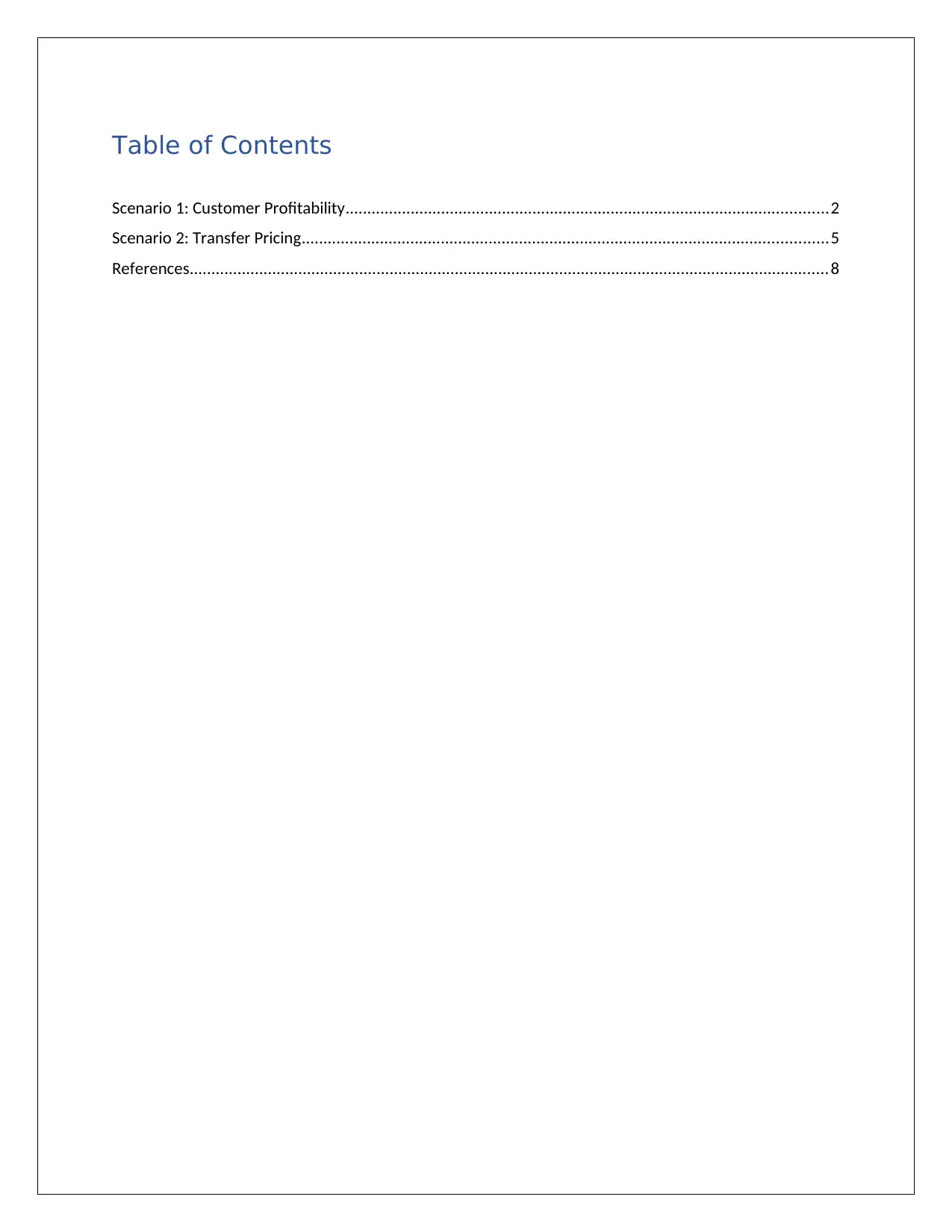
Table of Contents
Scenario 1: Customer Profitability...............................................................................................................2
Scenario 2: Transfer Pricing.........................................................................................................................5
References...................................................................................................................................................8
Scenario 1: Customer Profitability...............................................................................................................2
Scenario 2: Transfer Pricing.........................................................................................................................5
References...................................................................................................................................................8
Paraphrase This Document
Need a fresh take? Get an instant paraphrase of this document with our AI Paraphraser
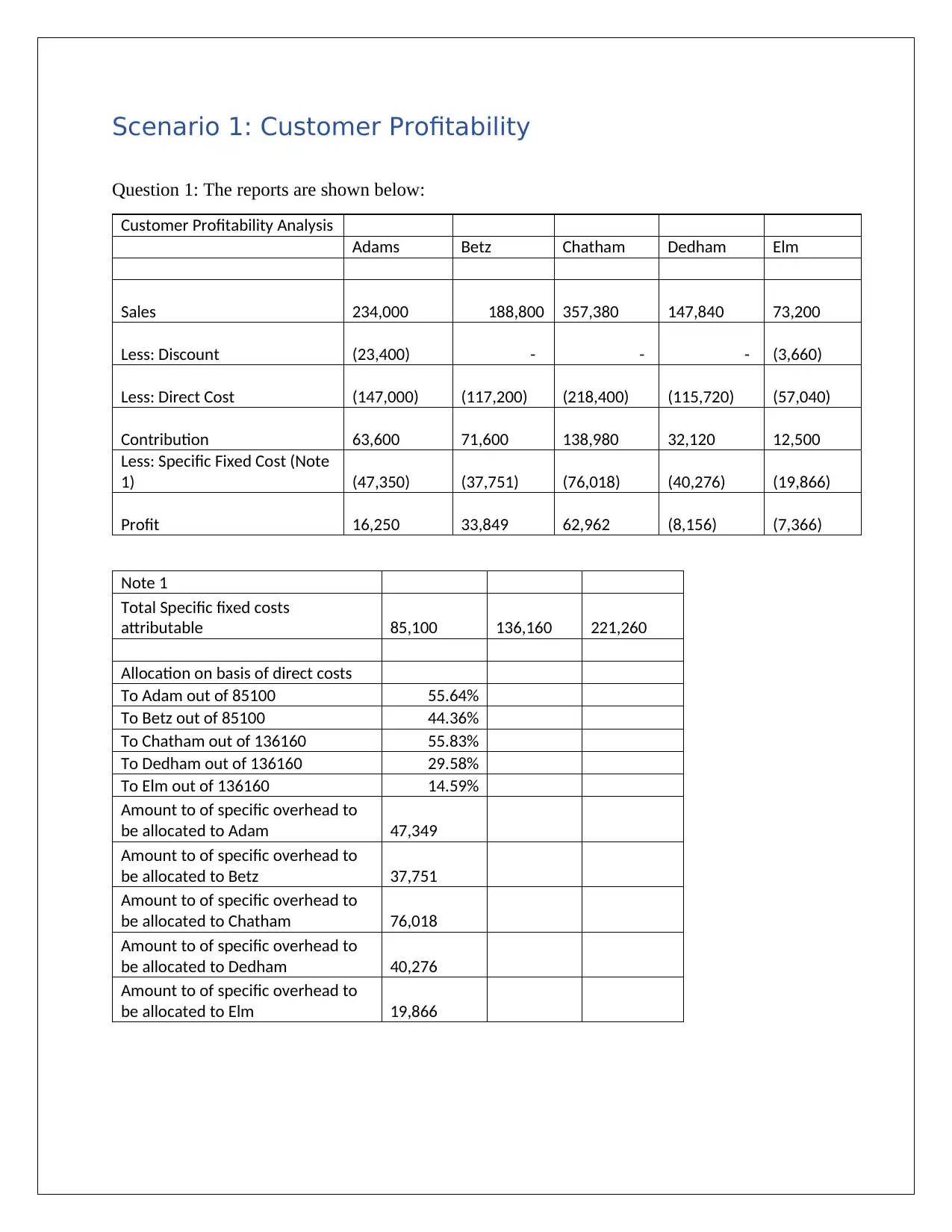
Scenario 1: Customer Profitability
Question 1: The reports are shown below:
Customer Profitability Analysis
Adams Betz Chatham Dedham Elm
Sales 234,000 188,800 357,380 147,840 73,200
Less: Discount (23,400) - - - (3,660)
Less: Direct Cost (147,000) (117,200) (218,400) (115,720) (57,040)
Contribution 63,600 71,600 138,980 32,120 12,500
Less: Specific Fixed Cost (Note
1) (47,350) (37,751) (76,018) (40,276) (19,866)
Profit 16,250 33,849 62,962 (8,156) (7,366)
Note 1
Total Specific fixed costs
attributable 85,100 136,160 221,260
Allocation on basis of direct costs
To Adam out of 85100 55.64%
To Betz out of 85100 44.36%
To Chatham out of 136160 55.83%
To Dedham out of 136160 29.58%
To Elm out of 136160 14.59%
Amount to of specific overhead to
be allocated to Adam 47,349
Amount to of specific overhead to
be allocated to Betz 37,751
Amount to of specific overhead to
be allocated to Chatham 76,018
Amount to of specific overhead to
be allocated to Dedham 40,276
Amount to of specific overhead to
be allocated to Elm 19,866
Question 1: The reports are shown below:
Customer Profitability Analysis
Adams Betz Chatham Dedham Elm
Sales 234,000 188,800 357,380 147,840 73,200
Less: Discount (23,400) - - - (3,660)
Less: Direct Cost (147,000) (117,200) (218,400) (115,720) (57,040)
Contribution 63,600 71,600 138,980 32,120 12,500
Less: Specific Fixed Cost (Note
1) (47,350) (37,751) (76,018) (40,276) (19,866)
Profit 16,250 33,849 62,962 (8,156) (7,366)
Note 1
Total Specific fixed costs
attributable 85,100 136,160 221,260
Allocation on basis of direct costs
To Adam out of 85100 55.64%
To Betz out of 85100 44.36%
To Chatham out of 136160 55.83%
To Dedham out of 136160 29.58%
To Elm out of 136160 14.59%
Amount to of specific overhead to
be allocated to Adam 47,349
Amount to of specific overhead to
be allocated to Betz 37,751
Amount to of specific overhead to
be allocated to Chatham 76,018
Amount to of specific overhead to
be allocated to Dedham 40,276
Amount to of specific overhead to
be allocated to Elm 19,866
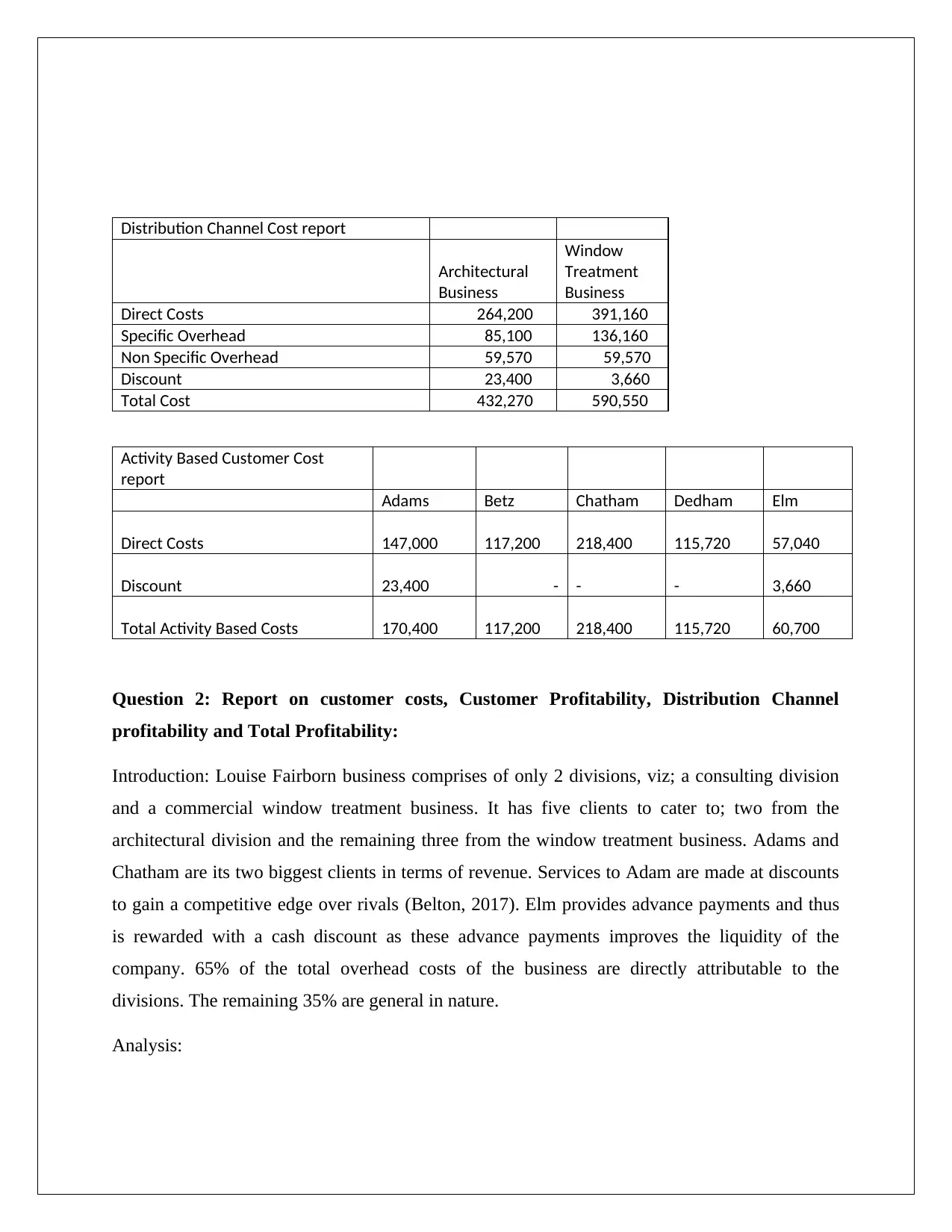
Distribution Channel Cost report
Architectural
Business
Window
Treatment
Business
Direct Costs 264,200 391,160
Specific Overhead 85,100 136,160
Non Specific Overhead 59,570 59,570
Discount 23,400 3,660
Total Cost 432,270 590,550
Activity Based Customer Cost
report
Adams Betz Chatham Dedham Elm
Direct Costs 147,000 117,200 218,400 115,720 57,040
Discount 23,400 - - - 3,660
Total Activity Based Costs 170,400 117,200 218,400 115,720 60,700
Question 2: Report on customer costs, Customer Profitability, Distribution Channel
profitability and Total Profitability:
Introduction: Louise Fairborn business comprises of only 2 divisions, viz; a consulting division
and a commercial window treatment business. It has five clients to cater to; two from the
architectural division and the remaining three from the window treatment business. Adams and
Chatham are its two biggest clients in terms of revenue. Services to Adam are made at discounts
to gain a competitive edge over rivals (Belton, 2017). Elm provides advance payments and thus
is rewarded with a cash discount as these advance payments improves the liquidity of the
company. 65% of the total overhead costs of the business are directly attributable to the
divisions. The remaining 35% are general in nature.
Analysis:
Architectural
Business
Window
Treatment
Business
Direct Costs 264,200 391,160
Specific Overhead 85,100 136,160
Non Specific Overhead 59,570 59,570
Discount 23,400 3,660
Total Cost 432,270 590,550
Activity Based Customer Cost
report
Adams Betz Chatham Dedham Elm
Direct Costs 147,000 117,200 218,400 115,720 57,040
Discount 23,400 - - - 3,660
Total Activity Based Costs 170,400 117,200 218,400 115,720 60,700
Question 2: Report on customer costs, Customer Profitability, Distribution Channel
profitability and Total Profitability:
Introduction: Louise Fairborn business comprises of only 2 divisions, viz; a consulting division
and a commercial window treatment business. It has five clients to cater to; two from the
architectural division and the remaining three from the window treatment business. Adams and
Chatham are its two biggest clients in terms of revenue. Services to Adam are made at discounts
to gain a competitive edge over rivals (Belton, 2017). Elm provides advance payments and thus
is rewarded with a cash discount as these advance payments improves the liquidity of the
company. 65% of the total overhead costs of the business are directly attributable to the
divisions. The remaining 35% are general in nature.
Analysis:
⊘ This is a preview!⊘
Do you want full access?
Subscribe today to unlock all pages.

Trusted by 1+ million students worldwide
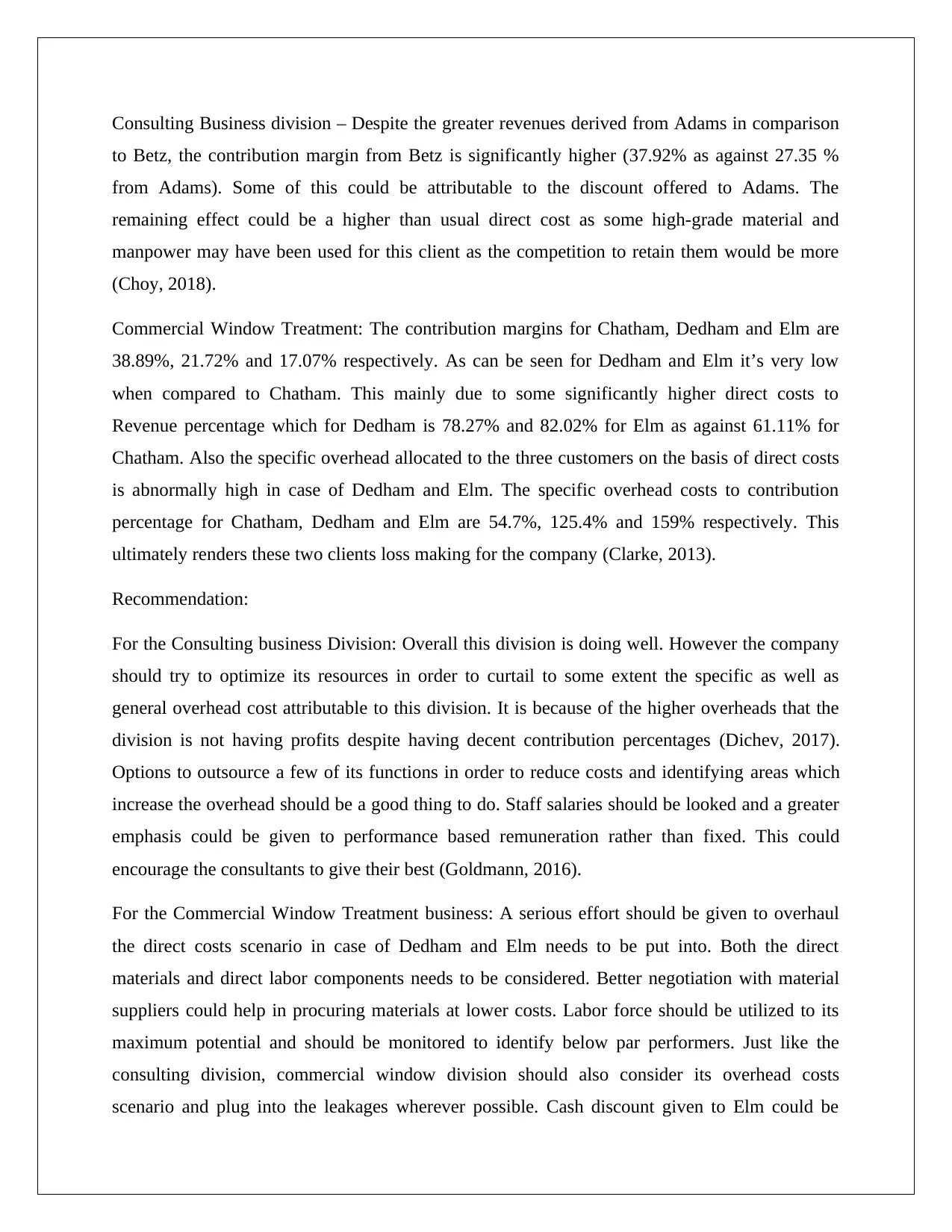
Consulting Business division – Despite the greater revenues derived from Adams in comparison
to Betz, the contribution margin from Betz is significantly higher (37.92% as against 27.35 %
from Adams). Some of this could be attributable to the discount offered to Adams. The
remaining effect could be a higher than usual direct cost as some high-grade material and
manpower may have been used for this client as the competition to retain them would be more
(Choy, 2018).
Commercial Window Treatment: The contribution margins for Chatham, Dedham and Elm are
38.89%, 21.72% and 17.07% respectively. As can be seen for Dedham and Elm it’s very low
when compared to Chatham. This mainly due to some significantly higher direct costs to
Revenue percentage which for Dedham is 78.27% and 82.02% for Elm as against 61.11% for
Chatham. Also the specific overhead allocated to the three customers on the basis of direct costs
is abnormally high in case of Dedham and Elm. The specific overhead costs to contribution
percentage for Chatham, Dedham and Elm are 54.7%, 125.4% and 159% respectively. This
ultimately renders these two clients loss making for the company (Clarke, 2013).
Recommendation:
For the Consulting business Division: Overall this division is doing well. However the company
should try to optimize its resources in order to curtail to some extent the specific as well as
general overhead cost attributable to this division. It is because of the higher overheads that the
division is not having profits despite having decent contribution percentages (Dichev, 2017).
Options to outsource a few of its functions in order to reduce costs and identifying areas which
increase the overhead should be a good thing to do. Staff salaries should be looked and a greater
emphasis could be given to performance based remuneration rather than fixed. This could
encourage the consultants to give their best (Goldmann, 2016).
For the Commercial Window Treatment business: A serious effort should be given to overhaul
the direct costs scenario in case of Dedham and Elm needs to be put into. Both the direct
materials and direct labor components needs to be considered. Better negotiation with material
suppliers could help in procuring materials at lower costs. Labor force should be utilized to its
maximum potential and should be monitored to identify below par performers. Just like the
consulting division, commercial window division should also consider its overhead costs
scenario and plug into the leakages wherever possible. Cash discount given to Elm could be
to Betz, the contribution margin from Betz is significantly higher (37.92% as against 27.35 %
from Adams). Some of this could be attributable to the discount offered to Adams. The
remaining effect could be a higher than usual direct cost as some high-grade material and
manpower may have been used for this client as the competition to retain them would be more
(Choy, 2018).
Commercial Window Treatment: The contribution margins for Chatham, Dedham and Elm are
38.89%, 21.72% and 17.07% respectively. As can be seen for Dedham and Elm it’s very low
when compared to Chatham. This mainly due to some significantly higher direct costs to
Revenue percentage which for Dedham is 78.27% and 82.02% for Elm as against 61.11% for
Chatham. Also the specific overhead allocated to the three customers on the basis of direct costs
is abnormally high in case of Dedham and Elm. The specific overhead costs to contribution
percentage for Chatham, Dedham and Elm are 54.7%, 125.4% and 159% respectively. This
ultimately renders these two clients loss making for the company (Clarke, 2013).
Recommendation:
For the Consulting business Division: Overall this division is doing well. However the company
should try to optimize its resources in order to curtail to some extent the specific as well as
general overhead cost attributable to this division. It is because of the higher overheads that the
division is not having profits despite having decent contribution percentages (Dichev, 2017).
Options to outsource a few of its functions in order to reduce costs and identifying areas which
increase the overhead should be a good thing to do. Staff salaries should be looked and a greater
emphasis could be given to performance based remuneration rather than fixed. This could
encourage the consultants to give their best (Goldmann, 2016).
For the Commercial Window Treatment business: A serious effort should be given to overhaul
the direct costs scenario in case of Dedham and Elm needs to be put into. Both the direct
materials and direct labor components needs to be considered. Better negotiation with material
suppliers could help in procuring materials at lower costs. Labor force should be utilized to its
maximum potential and should be monitored to identify below par performers. Just like the
consulting division, commercial window division should also consider its overhead costs
scenario and plug into the leakages wherever possible. Cash discount given to Elm could be
Paraphrase This Document
Need a fresh take? Get an instant paraphrase of this document with our AI Paraphraser
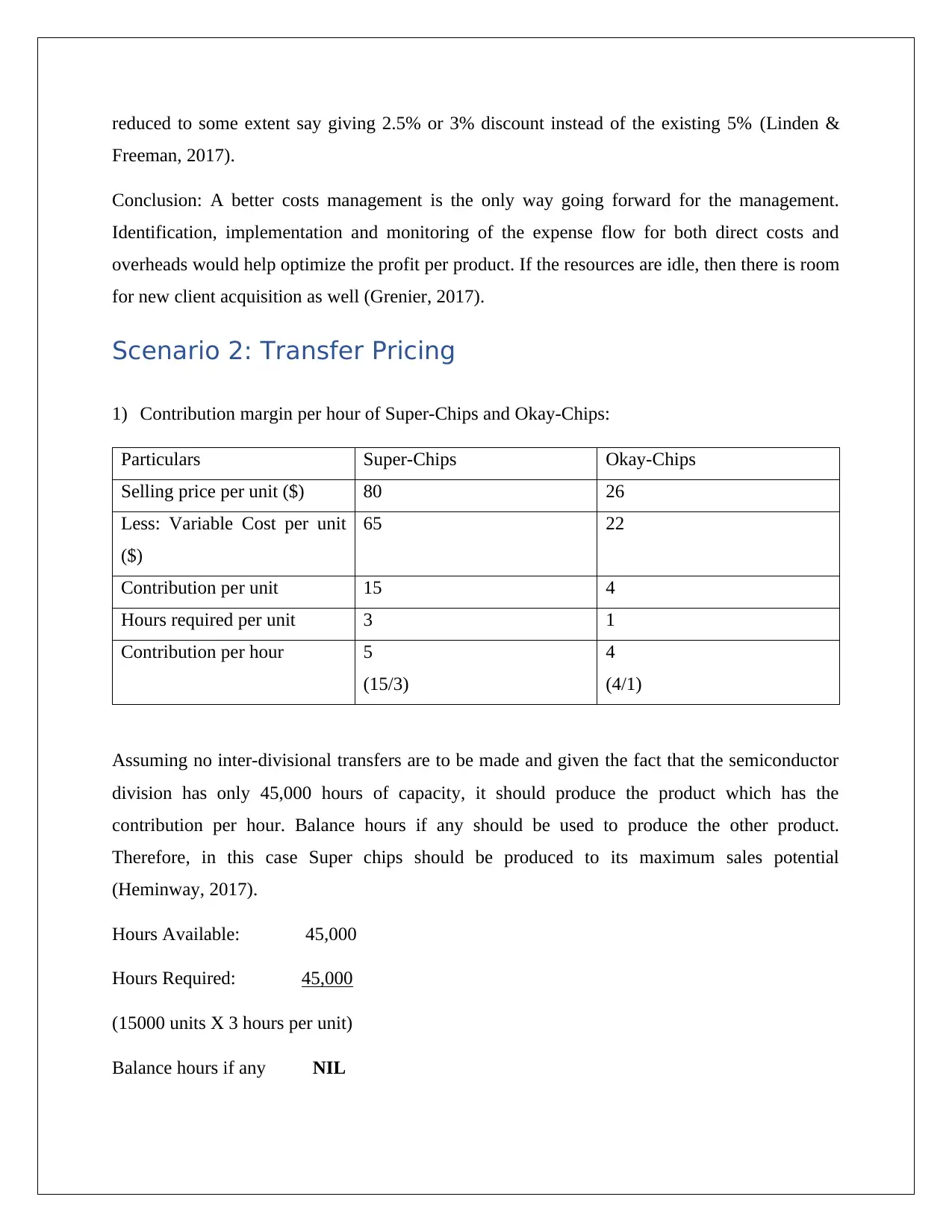
reduced to some extent say giving 2.5% or 3% discount instead of the existing 5% (Linden &
Freeman, 2017).
Conclusion: A better costs management is the only way going forward for the management.
Identification, implementation and monitoring of the expense flow for both direct costs and
overheads would help optimize the profit per product. If the resources are idle, then there is room
for new client acquisition as well (Grenier, 2017).
Scenario 2: Transfer Pricing
1) Contribution margin per hour of Super-Chips and Okay-Chips:
Particulars Super-Chips Okay-Chips
Selling price per unit ($) 80 26
Less: Variable Cost per unit
($)
65 22
Contribution per unit 15 4
Hours required per unit 3 1
Contribution per hour 5
(15/3)
4
(4/1)
Assuming no inter-divisional transfers are to be made and given the fact that the semiconductor
division has only 45,000 hours of capacity, it should produce the product which has the
contribution per hour. Balance hours if any should be used to produce the other product.
Therefore, in this case Super chips should be produced to its maximum sales potential
(Heminway, 2017).
Hours Available: 45,000
Hours Required: 45,000
(15000 units X 3 hours per unit)
Balance hours if any NIL
Freeman, 2017).
Conclusion: A better costs management is the only way going forward for the management.
Identification, implementation and monitoring of the expense flow for both direct costs and
overheads would help optimize the profit per product. If the resources are idle, then there is room
for new client acquisition as well (Grenier, 2017).
Scenario 2: Transfer Pricing
1) Contribution margin per hour of Super-Chips and Okay-Chips:
Particulars Super-Chips Okay-Chips
Selling price per unit ($) 80 26
Less: Variable Cost per unit
($)
65 22
Contribution per unit 15 4
Hours required per unit 3 1
Contribution per hour 5
(15/3)
4
(4/1)
Assuming no inter-divisional transfers are to be made and given the fact that the semiconductor
division has only 45,000 hours of capacity, it should produce the product which has the
contribution per hour. Balance hours if any should be used to produce the other product.
Therefore, in this case Super chips should be produced to its maximum sales potential
(Heminway, 2017).
Hours Available: 45,000
Hours Required: 45,000
(15000 units X 3 hours per unit)
Balance hours if any NIL

Therefore, the division should produce 15,000 units of super chip and therefore it can’t produce
any okay-chip as the capacity is exhausted.
2) Minimum Transfer price of Super-Chip to process division:
(Total Variable Cost of Super Chip + Variable cost of foregoing external sales of 5000 super-
chips)/ Number of units transferred
(65 X 5000 units + 5 X 15,000 hours) / 5000 = $ 80 per unit
Additional procurement cost for Process division = $ 80 - $ 70 = $ 10 which is less than the
additional selling price on the improved product which is $ 145 - $ 132 = $ 13. Hence there is
a $ 3 gain if the units are procured from semi-conductor division even at a higher price.
Therefore, the super-chips should be transferred to the Process control division to replace
circuit boards (Jefferson, 2017).
Contribution of Process control units using the circuit board:
3) The minimum transfer price for Semiconductor division would be its variable cost i.e., $ 65
for Super chips. The maximum transfer which Process division can pay is $ 83 beyond which
it can’t make additional contribution and therefore transfer beyond that price wouldn’t be
viable option for the process division. Any transfer price within the range of 65-83 would
ensure goal congruence for the entity (Visinescu, et al., 2017).
Particulars Super-Chips
Minimum Transfer price of Super-Chip to process division
(As per Part 2)
80
Add: Additional gain for process division on by the use of super
chip
(145-132)
13
Less: Additional procurement cost for process division (80-70) 10
Maximum price at which process division can procure goods from
its sister concern without a loss to themselves
83
4) Total Capacity: 60,000 hours
any okay-chip as the capacity is exhausted.
2) Minimum Transfer price of Super-Chip to process division:
(Total Variable Cost of Super Chip + Variable cost of foregoing external sales of 5000 super-
chips)/ Number of units transferred
(65 X 5000 units + 5 X 15,000 hours) / 5000 = $ 80 per unit
Additional procurement cost for Process division = $ 80 - $ 70 = $ 10 which is less than the
additional selling price on the improved product which is $ 145 - $ 132 = $ 13. Hence there is
a $ 3 gain if the units are procured from semi-conductor division even at a higher price.
Therefore, the super-chips should be transferred to the Process control division to replace
circuit boards (Jefferson, 2017).
Contribution of Process control units using the circuit board:
3) The minimum transfer price for Semiconductor division would be its variable cost i.e., $ 65
for Super chips. The maximum transfer which Process division can pay is $ 83 beyond which
it can’t make additional contribution and therefore transfer beyond that price wouldn’t be
viable option for the process division. Any transfer price within the range of 65-83 would
ensure goal congruence for the entity (Visinescu, et al., 2017).
Particulars Super-Chips
Minimum Transfer price of Super-Chip to process division
(As per Part 2)
80
Add: Additional gain for process division on by the use of super
chip
(145-132)
13
Less: Additional procurement cost for process division (80-70) 10
Maximum price at which process division can procure goods from
its sister concern without a loss to themselves
83
4) Total Capacity: 60,000 hours
⊘ This is a preview!⊘
Do you want full access?
Subscribe today to unlock all pages.

Trusted by 1+ million students worldwide

Hours Required for External sales requirement for Super-Chip = 15000 X 3 = 45,000 hours
Hours required for manufacturing 5,000 units for Process Division = 5000 X 3 = 15000 hours
Unused capacity, if any: NIL.
Therefore, in the scenario of semi-conductor division having 60,000 hours of capacity it can
meet both the demands of external sales as well as the 5000 unit of requirement of super-chip
from the process divisional without any conflict (Sithole, et al., 2017).
Contribution of Process control units without using super-chip
Particulars Amount in $
Selling price per unit 132
Variable Cost:
Circuit board 70
Direct Labor 45
Contribution per unit 17
Contribution of Process control units using the Super-Chip
Particulars Amount in $
Selling price per unit 145
Variable Cost:
Super Chip Transfer pricing cost
80
Direct Labor 45
Contribution per unit 20
Incremental Contribution per unit = $ 3.
The company would earn a total incremental contribution of 5,000 X 3 = $ 15,000.
Hours required for manufacturing 5,000 units for Process Division = 5000 X 3 = 15000 hours
Unused capacity, if any: NIL.
Therefore, in the scenario of semi-conductor division having 60,000 hours of capacity it can
meet both the demands of external sales as well as the 5000 unit of requirement of super-chip
from the process divisional without any conflict (Sithole, et al., 2017).
Contribution of Process control units without using super-chip
Particulars Amount in $
Selling price per unit 132
Variable Cost:
Circuit board 70
Direct Labor 45
Contribution per unit 17
Contribution of Process control units using the Super-Chip
Particulars Amount in $
Selling price per unit 145
Variable Cost:
Super Chip Transfer pricing cost
80
Direct Labor 45
Contribution per unit 20
Incremental Contribution per unit = $ 3.
The company would earn a total incremental contribution of 5,000 X 3 = $ 15,000.
Paraphrase This Document
Need a fresh take? Get an instant paraphrase of this document with our AI Paraphraser
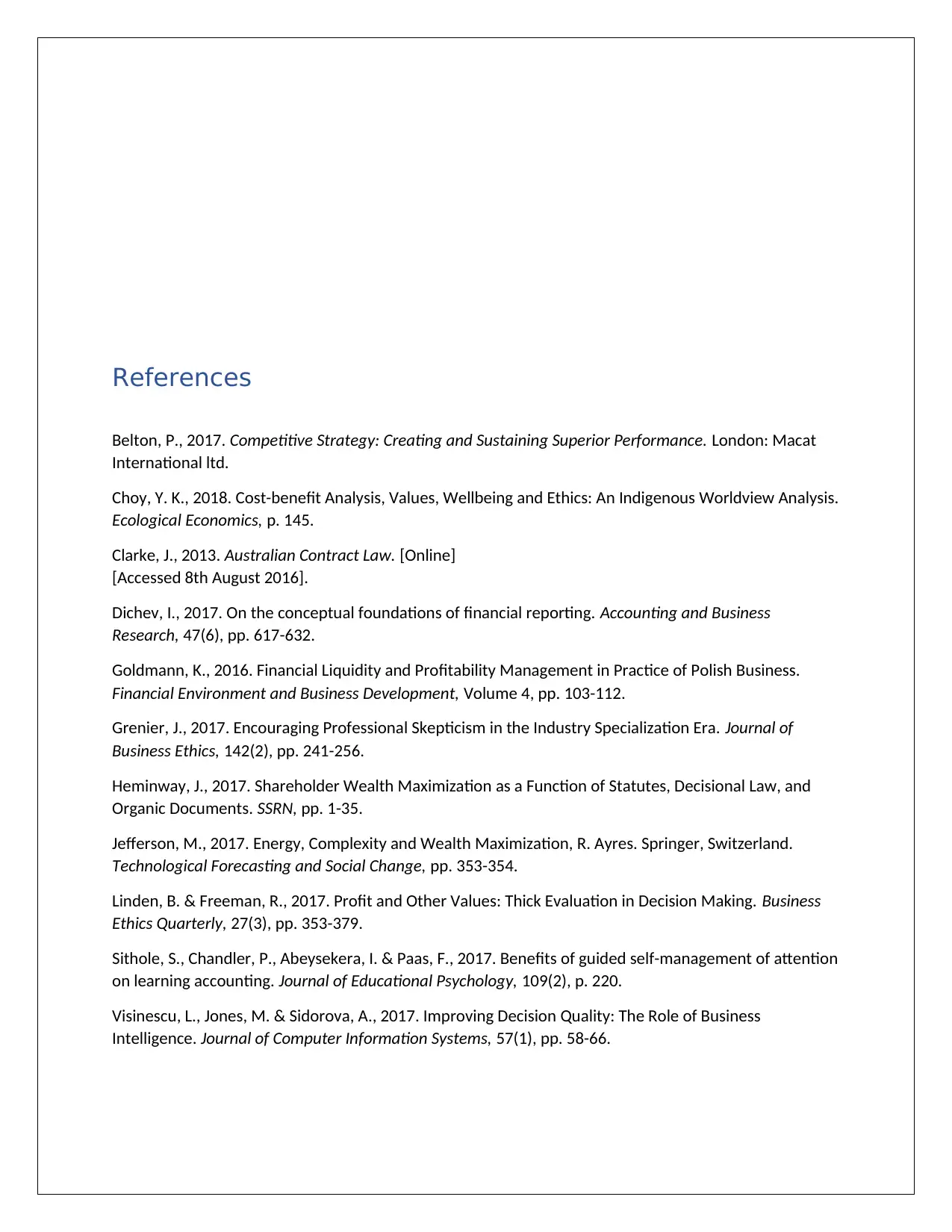
References
Belton, P., 2017. Competitive Strategy: Creating and Sustaining Superior Performance. London: Macat
International ltd.
Choy, Y. K., 2018. Cost-benefit Analysis, Values, Wellbeing and Ethics: An Indigenous Worldview Analysis.
Ecological Economics, p. 145.
Clarke, J., 2013. Australian Contract Law. [Online]
[Accessed 8th August 2016].
Dichev, I., 2017. On the conceptual foundations of financial reporting. Accounting and Business
Research, 47(6), pp. 617-632.
Goldmann, K., 2016. Financial Liquidity and Profitability Management in Practice of Polish Business.
Financial Environment and Business Development, Volume 4, pp. 103-112.
Grenier, J., 2017. Encouraging Professional Skepticism in the Industry Specialization Era. Journal of
Business Ethics, 142(2), pp. 241-256.
Heminway, J., 2017. Shareholder Wealth Maximization as a Function of Statutes, Decisional Law, and
Organic Documents. SSRN, pp. 1-35.
Jefferson, M., 2017. Energy, Complexity and Wealth Maximization, R. Ayres. Springer, Switzerland.
Technological Forecasting and Social Change, pp. 353-354.
Linden, B. & Freeman, R., 2017. Profit and Other Values: Thick Evaluation in Decision Making. Business
Ethics Quarterly, 27(3), pp. 353-379.
Sithole, S., Chandler, P., Abeysekera, I. & Paas, F., 2017. Benefits of guided self-management of attention
on learning accounting. Journal of Educational Psychology, 109(2), p. 220.
Visinescu, L., Jones, M. & Sidorova, A., 2017. Improving Decision Quality: The Role of Business
Intelligence. Journal of Computer Information Systems, 57(1), pp. 58-66.
Belton, P., 2017. Competitive Strategy: Creating and Sustaining Superior Performance. London: Macat
International ltd.
Choy, Y. K., 2018. Cost-benefit Analysis, Values, Wellbeing and Ethics: An Indigenous Worldview Analysis.
Ecological Economics, p. 145.
Clarke, J., 2013. Australian Contract Law. [Online]
[Accessed 8th August 2016].
Dichev, I., 2017. On the conceptual foundations of financial reporting. Accounting and Business
Research, 47(6), pp. 617-632.
Goldmann, K., 2016. Financial Liquidity and Profitability Management in Practice of Polish Business.
Financial Environment and Business Development, Volume 4, pp. 103-112.
Grenier, J., 2017. Encouraging Professional Skepticism in the Industry Specialization Era. Journal of
Business Ethics, 142(2), pp. 241-256.
Heminway, J., 2017. Shareholder Wealth Maximization as a Function of Statutes, Decisional Law, and
Organic Documents. SSRN, pp. 1-35.
Jefferson, M., 2017. Energy, Complexity and Wealth Maximization, R. Ayres. Springer, Switzerland.
Technological Forecasting and Social Change, pp. 353-354.
Linden, B. & Freeman, R., 2017. Profit and Other Values: Thick Evaluation in Decision Making. Business
Ethics Quarterly, 27(3), pp. 353-379.
Sithole, S., Chandler, P., Abeysekera, I. & Paas, F., 2017. Benefits of guided self-management of attention
on learning accounting. Journal of Educational Psychology, 109(2), p. 220.
Visinescu, L., Jones, M. & Sidorova, A., 2017. Improving Decision Quality: The Role of Business
Intelligence. Journal of Computer Information Systems, 57(1), pp. 58-66.
1 out of 8
Related Documents
Your All-in-One AI-Powered Toolkit for Academic Success.
+13062052269
info@desklib.com
Available 24*7 on WhatsApp / Email
![[object Object]](/_next/static/media/star-bottom.7253800d.svg)
Unlock your academic potential
Copyright © 2020–2025 A2Z Services. All Rights Reserved. Developed and managed by ZUCOL.




